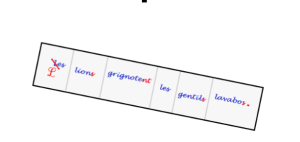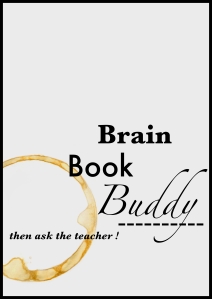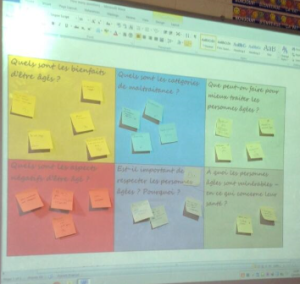On Wednesday 17th June a group of MFL teachers got together @DowneHouse1 to connect, share ideas and learn from each other. As I said on the night, if there was ever any doubt that Modern Language Teachers are passionate about what they do then this TeachMeet proved otherwise. There were about 60 linguists (and representatives from other subject areas) from all sectors and all stages of education. There was a real buzz and four days on that buzz is still there for me and the colleagues in my department.
Our CPD kicked off in style with Mark Anderson @ictevangelist providing our keynote. Mark judged our needs perfectly and talked to us about the power of TeachMeets and sharing ideas. Mark told us that ‘languages are a force for good’ and none of us would disagree with that. Mark took us through some tools that we can use to develop language skills. Tools such as Ivona.com text to speech tool, Tellagami for motivating students to speak, Post-it Plus app which has many uses not least assessing learning. (Read more about this app here).
@GemmaLaundon summed up the Keynote as follows:
https://twitter.com/GemmaLaundon/status/611214013997953024 I could not agree more!
However, the TeachMeet did not end there. We were treated to a number of excellent presentations. Jane Bradbury showed us the wonderful La Maison Claire Fontaine which looks like a fantastic place to experience French in situ. Cheng-Han Wu (@wu_lao_shi) treated us to a two minute presentation entitled More of the Same vs Higher Order Thinking Skills. It’s amazing what can be achieved in such a short time. Cheng’s message was powerful and pushed home the importance of practice.
https://twitter.com/get_sme/status/611219978000404481
Mary Wood, @stbarts3, who wowed us all last year with some of her classroom teaching ideas and her use of memrise.com, came back to tell us about new features on this language learning website. Setting up a department area seems like a good plan and one that we will be following through.
Then @basnettj shared her love of @GetKahoot. It did not take long for the audience to pick up the benefits of this tool. Before long there was a good bit of competition going on and colleagues could see that not only does this online tool bring an element of fun and competition to the class it also provides some excellent feedback. You can read more about GetKahoot here.
The perennial problem for language teachers is getting students to speak spontaneously. Fortunately, Ali Quick, @MFLmissquick, had a few ideas to combat this issue. Ali’s De Bono’s thinking hats and her lovely colourful mats were an instant hit.
The first half was rounded off by a virtual presentation. Unable to make it in time from the Isle of Man Rachel Smith kindly recorded a video for us on sketchnoting. @lancslassrach is a keen sketchnoter herself making great use of Paper by Fifty Three. Sketchnoting with classes is not something that many of us had considered but Rachel’s presentation certainly gave us all some food for thought.
Philip Montague, @get_sme, from Microsoft, got the second half off to an amazing start. He spoke to us about Digital Foreign Exchange and enlisted the help of his son via Skype. We all know the power of minecraft but seeing a young boy picking up a few words in a foreign language whilst working his way through a minecraft maze was pretty special and certainly drove home an important message for us all. There are so many ways that this tool could be successfully exploited for use in MFL.
We then heard from @this_islanguage, @befluentBFIN, @leVocab and @vocabexpress all took a couple of minutes to talk about the opportunities provided by their online language learning tools. If you do not know them then do check them out!
Gemma Laundon, @GemmaLaundon spoke to us all about spontaneous writing activities. Getting students to write spontaneously is always quite tricky and Gemma reminded us of some good games we could play. Consequences definitely seems a good one to get them writing.

We were then really grateful to Anna Comas-Quinn, @AComasQuinn from the OU for sharing her knowledge and expertise on Open Educational Resources and Creative Commons. Teach Meets are all about sharing great ideas so it seems right that Anna talked to us about sharing resources.
The evening drew to a close with three great presentations. The first from Kirsty de Groot, @phrancophilly talked us through some fabulous ideas for the MFL classroom for use with all age groups even. Google classroom and Edmodo are just some of the tools Kirsty mentioned. Clearly her students are really well prepared for secondary school.
https://twitter.com/GemmaLaundon/status/611238611091095554 Kirsty’s ‘sell a teacher on ebay’ idea went down a treat.
Next up was Joe Dale, @joedale is a master at using technology in the MFL classroom and thus it was no surprise that he created a personalised talking photo story right there at our TeachMeet. The audience were duly impressed with his brilliant Book Creator photo stories and his ideas about sharing them using Padlet.
Our evening was rounded off in style by Crista Hazell, @CristaHazell. Crista reminded us of the need for creativity in MFL so that we can enable pupils to access the language they are being taught.
https://twitter.com/leVocab/status/611242308470734848 Crista gave us so much to think about and consider our minds were buzzing with ideas. She talked about keeping the sparkle in our students’ eyes and gave us ideas on how to achieve this. Crista managed to put a sparkle in our eyes too! https://twitter.com/wu_lao_shi/status/611245740053168129
The enthusiasm from Crista and all the presenters was infectious. We proved that MFL Rocks (and so do MFL Teachers!).
https://twitter.com/wu_lao_shi/status/611274754427867136
We can not wait for our next MFL TeachMeet -#DHLang15 – and have decided to break up the long wait with a multi-discipline TeachMeet in November. If you would like to sign up for #EduDH15 you can do so by clicking on #EduDH15
We look forward to seeing you.
You can access the presentations here: Cheng-Han Wu: MOTS & HOTS Ali Quick: Be spontaneous! Rachel Smith: Sketchnoting Gemma Laundon: Spontaneous writing skills Anna Comas-Quinn: Open content and pedagogy Crista Hazell: Creativity in MFL
























